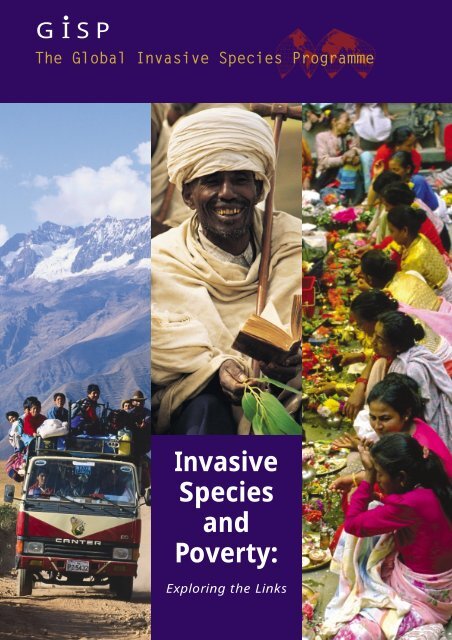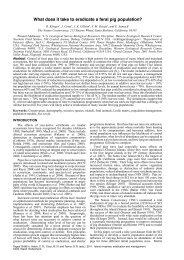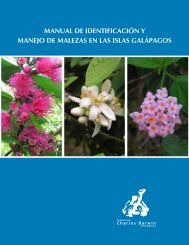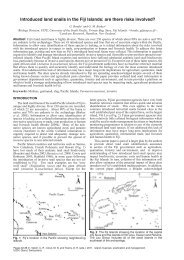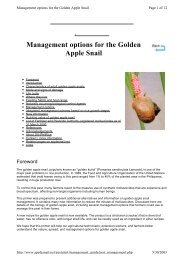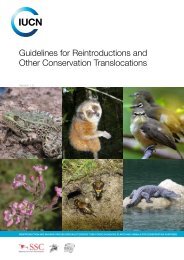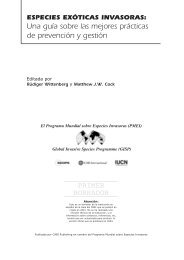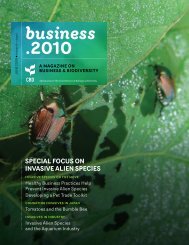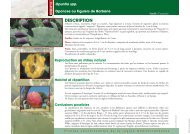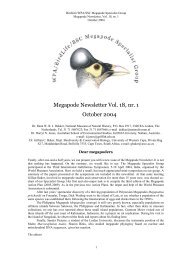English - IUCN Invasive Species Specialist Group
English - IUCN Invasive Species Specialist Group
English - IUCN Invasive Species Specialist Group
Create successful ePaper yourself
Turn your PDF publications into a flip-book with our unique Google optimized e-Paper software.
GISP<br />
The Global <strong>Invasive</strong> <strong>Species</strong> Programme<br />
<strong>Invasive</strong><br />
<strong>Species</strong><br />
and<br />
Poverty:<br />
Exploring the Links
Foreword<br />
<strong>Invasive</strong> alien species are more often than not pigeon-holed as an<br />
environmental or biodiversity issue, and consequently – especially in<br />
developing countries – do not receive due recognition by policy-makers.<br />
Yet the reality is that they are a major threat to human livelihoods,<br />
especially to agriculture and therefore food security, and are generally<br />
undermining human well-being. Moreover, ongoing globalisation and<br />
increasing trade are escalating the problem to critical proportions. We hope<br />
that this booklet will contribute towards a better understanding of these<br />
links and to placing invasive species firmly on the development agenda.<br />
Dennis Rangi<br />
Chair: GISP Board<br />
The GISP mission is to conserve biodiversity<br />
and sustain human livelihoods by minimising<br />
the spread and deleterious impact of<br />
invasive alien species.
Contents<br />
2 Biodiversity, Ecosystem Services and Human Well-being<br />
4 <strong>Invasive</strong> <strong>Species</strong> as a Factor in Biodiversity Loss and Ecosystem Change<br />
6 The Costs of <strong>Invasive</strong> <strong>Species</strong> Impacts<br />
8 Rural Communities Bearing the Brunt<br />
10 <strong>Invasive</strong> <strong>Species</strong> and Food Security in Africa<br />
11 <strong>Invasive</strong> <strong>Species</strong> and the Millennium Development Goals
Biodiversity, Ecosystem Services and Human Well-being<br />
The Millennium Ecosystem Assessment 1 defined five primary components of human<br />
well-being: the basic materials for life (such as food, shelter and livelihood options);<br />
health (including clean air and water); security; good social relations; and freedom of<br />
choice and actions. And while the accessibility of these to any particular individual or<br />
community is significantly influenced by their socio-political circumstances, the availability<br />
of many is dependent on biodiversity, ecosystems and ecosystem services.<br />
Biodiversity is often described as ‘the diversity of Life on Earth’, encompassing all genes, species, populations<br />
and ecosystems. It is essential for the functioning of healthy ecosystems, which in turn provide a variety of<br />
services vital for human well-being.<br />
These ‘ecosystem services’ include resources such as food, water, building material and traditional medicines;<br />
processes regulating water purification, soil formation, flood attenuation, erosion control, crop pollination<br />
and nutrient cycling, as well as cultural aspects such as recreational opportunities and spiritual fulfillment.<br />
HUMAN WELL-BEING<br />
AND POVERTY REDUCTION<br />
Basic materials for a good life<br />
Good social relations<br />
Security<br />
Freedom of choice and action<br />
DRIVERS OF BIODIVERSITY LOSS<br />
AND ECOSYSTEM CHANGE<br />
Climate change<br />
Habitat destruction<br />
Pollution<br />
Overexploitation<br />
<strong>Invasive</strong> alien species<br />
ECOSYSTEM SERVICES<br />
Provisioning (e.g. food, water, fiber and fuel)<br />
Regulating (e.g. climate, erosion and disease regulation)<br />
Cultural (e.g. spiritual, aesthetic, recreation and education)<br />
Supporting (e.g. primary production and soil formation<br />
BIODIVERSITY<br />
Genes<br />
<strong>Species</strong><br />
Population<br />
Ecosystems<br />
The Millennium Ecosystem Assessment was conducted between 2001 and 2005 to assess the<br />
consequences of ecosystem change for human well-being, and to analyse options available<br />
to enhance the conservation and sustainable use of ecosystems and their contributions to<br />
human well-being. Carried out by some 1360 experts from 95 countries, it developed four<br />
global scenarios exploring plausible future changes in drivers, ecosystems, ecosystem services,<br />
and human well-being. It also examined the strengths and weaknesses of various response<br />
options that have been used to manage ecosystem services, and identified promising<br />
opportunities for enhancing human well-being while conserving ecosystems.<br />
2
It follows that the loss of biodiversity and degradation of ecosystems inevitably affects human well-being,<br />
contributing to lower food security, harsher living conditions, worsening health, and reduced wealth.<br />
Particularly vulnerable are the poor, who, to a large extent, are directly dependent on biodiversity-based<br />
goods and the associated ecosystem services for their livelihoods. In Africa, for example, agriculture provides<br />
60% of all employment, and 80% for populations in rural areas 2 .<br />
It is of great concern, therefore, that over the past few hundred years species extinction rates have increased<br />
by as much as 1000 times, and that amongst the higher taxa, the majority of species are in decline. The<br />
Living Planet Index – an aggregate indicator of the state of biodiversity – showed, for example, a drop in the<br />
index for freshwater species of about 50% between 1970 and 2001 3 . The Millennium Ecosystem Assessment<br />
also found that humans have changed Earth’s natural<br />
ecosystems more rapidly and extensively in the last 50 years<br />
than in any other period. About 35% of the world’s<br />
mangroves have been lost over the last two decades 4 ,<br />
while some 13 million hectares of forest are lost each<br />
year due to deforestation 5 .<br />
The Millennium Ecosystem Assessment identified the main<br />
drivers of biodiversity loss and ecosystem services as climate<br />
change, unsustainable resource use in the form of overexploitation,<br />
pollution and habitat destruction, and<br />
invasive alien species – all due to human activity.<br />
3<br />
The Convention on Biological Diversity defines biodiversity loss as “the long-term or<br />
permanent qualitative or quantitative reduction in components of biodiversity and their<br />
potential to provide goods and services, to be measured at global, regional and national<br />
levels”. The Convention’s member countries have committed to achieving a significant<br />
reduction of the current rate of biodiversity loss at the global, regional and national level<br />
as a contribution to poverty alleviation and to the benefit of all life on earth by 2010 –<br />
the so-called 2010 Target.<br />
3
<strong>Invasive</strong> <strong>Species</strong> as a Factor in Biodiversity Loss<br />
and Ecosystem Change<br />
<strong>Invasive</strong> alien species are species that are introduced as a consequence of human activities<br />
to new geographic areas, where they become established and then proliferate and spread,<br />
to the detriment of human interests and natural systems.<br />
While the problems caused by invasive species have been evident for many years, the issue has become<br />
increasingly important during the last half-century, as the globalisation of trade and industry has resulted in<br />
increased mobility of people and goods, and the associated transport of plants, animals and micro-organisms<br />
around the world. Furthermore, it is anticipated that the problem will be exacerbated in future by climate<br />
change, which is likely to favour species that are opportunistic – a characteristic of many invaders.<br />
AQUACULTURE – primarily based on species<br />
introduced intentionally – is one of the<br />
fastest growing sectors of the global food<br />
economy, increasing by more than 10% per<br />
year and currently accounting for over 30%<br />
of all consumed finfish and shellfish. While<br />
there are clearly benefits in terms of food<br />
availability, there are many examples of<br />
cultured species – or their parasites –<br />
becoming invasive, with consequent<br />
negative effects outweighing the benefits.<br />
SHIPPING is a major pathway for the<br />
unintentional introduction of aquatic<br />
invaders, which may be carried in ballast<br />
water and/or as fouling organisms on the<br />
hull and other parts of the vessel. The<br />
value of worldwide exports grew from<br />
US$192 billion in 1965 to $6.2 trillion in<br />
2000. As the primary mode of transport<br />
for these goods, it is estimated that the<br />
global shipping industry will more than<br />
double by the year 2020.<br />
<strong>Invasive</strong> species have now affected nearly every ecosystem type on the planet and pose one of the biggest<br />
threats to biodiversity worldwide 6,7 . They impact native species both directly – for example, by preying on and<br />
competing with them for resources such as food and breeding sites – as well as indirectly by altering habitat<br />
and modifying hydrology, fire regimes, nutrient cycling and other ecosystem processes. Together these<br />
impacts are resulting in the loss of biodiversity and dramatic changes to ecosystems, confirmed by a recent<br />
global assessment showing invasive alien species to have affected 30% of threatened birds (but as much as<br />
67% on islands), 11% of threatened amphibians, and 8% of threatened mammals 8 .<br />
The loss of biodiversity and the associated ecosystem services precipitated by invasive species – amongst<br />
other things – are, however, important not only in their own right. They clearly also have consequential<br />
impacts on human well-being.<br />
4
Infestations of invasive plants tend to modify fire<br />
regimes by increasing the frequency and intensity of<br />
wildfires. Their dense growth adds to the fuel load,<br />
while some species contain highly flammable<br />
compounds. Very hot fires may destroy the seeds of<br />
indigenous species, leading to a loss of biodiversity.<br />
<strong>Invasive</strong> species negatively impact biodiversity by altering<br />
ecosystem processes. For example, in South Africa’s Cape<br />
Floristic Region – world renown for its rich biodiversity –<br />
the Argentine ant has invaded fynbos communities,<br />
where it interferes with pollination and seed dispersal. Its<br />
aggressive behaviour deters some insect pollinators of<br />
fynbos plants, and also displaces native ants that disperse<br />
fynbos seeds. While the native ants carry seeds into their<br />
underground nests to consume the attached food body,<br />
Argentine ants leave the seeds on the surface, where they<br />
are exposed to fire and predation by rodents. Although<br />
fire is vital for germination of most fynbos plants, seed<br />
burial provides a buffer against intense heat, which<br />
destroys many seeds.<br />
Pine trees are invasive in most southern hemisphere<br />
countries where they were introduced, primarily for<br />
forestry purposes. In open ecosystems such as grasslands<br />
and savannas their higher water requirements<br />
have a dramatic effect on hydrology, particularly in<br />
catchment areas and along watercourses, where<br />
they reduce runoff and hence river flow. Dense<br />
stands of pines also lower the water table, displace<br />
native species, alter nutrient cycling and increase<br />
the risk of fire.<br />
Rats have a devastating impact on biodiversity. By<br />
preying on other species and competing with them<br />
for food, they have caused the decline of many small<br />
mammals, birds, reptiles and invertebrates. Their<br />
effect has been particularly severe on islands – they<br />
are responsible for more island extinctions of birds,<br />
snakes and lizards than any other predators.
The Costs of <strong>Invasive</strong> <strong>Species</strong> Impacts<br />
Apart from their threat to biodiversity and ecosystem services, invasive species have a<br />
significant socio-economic impact. They reduce yields from agriculture, forestry and<br />
fisheries, decrease water availability, cause costly land degradation, block transport routes<br />
and contribute to the spread of disease. They also reduce the effectiveness of development<br />
investments by, for example, choking irrigation canals, fouling industrial pipelines and<br />
threatening hydroelectric schemes. <strong>Invasive</strong> species therefore contribute to social instability<br />
and economic hardship, placing constraints on sustainable development, economic growth,<br />
poverty alleviation and food security.<br />
In 1993, the Office of Technology Assessment 9 of the US Congress estimated that the 79 most harmful invasive<br />
species had caused damage of $97 billion in the USA since 1906 10 . Pimental and colleagues 11-14 subsequently<br />
updated and extended these estimates to other countries. Annual losses to pests were estimated at US$ 6.24 billion<br />
in Australia, US$ 42.60 billion in Brazil, US$ 78.50 billion in USA, US$ 5.56 billion in the UK, US$ 91.02 billion in<br />
India and US$ 4.30 billion in South Africa. Globally, the costs of damage caused by invasive species has been put<br />
at US$ 1.4 trillion per year – close to 5% of global GDP 12 .<br />
While the methodology of these studies has been questioned, the figures provide an interesting comparison<br />
between developed and developing countries. Estimated damage caused by invasive species was equal to 53% of<br />
agricultural GDP in the USA, 31% in the UK and 48% in Australia. By contrast, the damage in South Africa, India<br />
and Brazil amounted to 96%, 78% and 112% of agricultural GDP of these developing countries respectively 12 .<br />
Given that agriculture accounts for a higher share of the GDP in developing countries, the impact of invasive<br />
species on overall economic performance is proportionately greater in developing countries. In India, for example,<br />
Pimentel’s estimates imply that the annual costs associated with invasive species control and damage amounted to<br />
20% of GDP in 1999, compared to less than 1% in the USA 12 . Apart from directly affecting the performance of<br />
these sectors, by impacting on the GDP, invasive species also reduce the ability of the affected Governments to<br />
allocate the funding required to address the problem, making them more prone to bioinvasions. Compounding<br />
the issue, these countries are then more vulnerable to trade embargoes based on the presence of invasive species.<br />
SPECIES ECONOMIC VARIABLE ECONOMIC IMPACT REFERENCE<br />
Introduced disease Annual cost to human, plant, $41 billion per year Daszak et al., 2000 15<br />
organisms<br />
animal health in USA<br />
Coypu/nutria Damages to agriculture and $2.8 million per year Panzacchi et al., 2004 16<br />
(aquatic rodent)<br />
river banks in Italy<br />
Zebra mussel Damages to US and European Cumulative costs 1988-2000 National Aquatic Nuisances<br />
industrial plants = $750 million to 1 billion <strong>Species</strong> Clearinghouse, 2000 17<br />
Six weed species Costs in Australia $105 million per year Watkinson, Freckleton &<br />
agroecosystems Dowling, 2000 18<br />
Pines, hakeas and acacias Costs on South African Floral $2 billion Turpie & Heydenrych, 2000 19<br />
Kingdom to restore to pristine state<br />
Water hyacinth Costs in 7 African countries $20-50 million per year Joffe-Cooke, 1997 20<br />
Varroa mite Economic cost to beekeeping $267-602 million Wittenberg & Cock, 2001 21<br />
in New Zealand<br />
Comb-jelly Lost anchovy fisheries in $17 million per year Knowler & Barbier, 2000 22<br />
Black Sea Knowler, 2005. 23<br />
Golden apple snail Damage to rice agriculture $28-45 million per year Naylor, 1996 24<br />
in Philippines<br />
(adapted from McNeely, 2004 25 )<br />
6
Water hyacinth is the world’s worst aquatic weed. Its<br />
dense growth blocks waterways and inhibits boat traffic,<br />
disrupting trade, fishing and recreational activities. The<br />
plant is a weed of wetland crops such as rice and jute,<br />
and often clogs irrigation canals and pumps, so it also<br />
impacts agricultural production. The floating mats<br />
threaten hydroelectric schemes, pose a health risk by<br />
creating suitable habitat for mosquitoes, snails and<br />
other vectors of disease, and can damage road and rail<br />
bridges when swept downriver during floods.<br />
The South American nutria, or coypu, was widely<br />
introduced for its thick, soft fur, but is now<br />
considered a pest because of its burrowing and<br />
feeding habitats. It causes considerable losses in<br />
crops such as rice, sugarcane, corn and soybean, as<br />
well as some fruit and vegetables. Its burrowing<br />
weakens the banks of rivers, dams and irrigation<br />
canals, and may undermine building foundations<br />
and road beds. By gnawing on wooden structures,<br />
nutria also damage buildings and jetties.<br />
The European wasp, also known as the German<br />
yellowjacket, has a severe economic impact in many<br />
invaded regions as it causes losses to beekeepers and<br />
fruit farmers. It attacks beehives to prey on bees and<br />
steal pollen and honey, and damages soft fruit,<br />
reducing their market value and making them more<br />
susceptible to infection.<br />
<strong>Invasive</strong> mussels typically cause massive fouling<br />
problems. They clog the intakes, pipes and filters of<br />
water treatment facilities, industrial plants and power<br />
stations, thereby reducing flow velocity, compromising<br />
efficiency and disrupting cooling systems. They impact<br />
aquaculture production by fouling cages and nets, and<br />
competing with other filter-feeders for planktonic<br />
food. Fouling on boat hulls increases drag, which<br />
reduces speed and increases fuel expenses, while<br />
clogging of the cooling intakes may cause the engine<br />
to overheat, with costly results.
Rural Communities Bearing the Brunt<br />
Developing countries are particularly vulnerable to the threats posed by invasive species<br />
because their economies typically rely heavily on agriculture, forestry and fishing. Moreover,<br />
within these countries it is generally the rural communities who are most at risk, as their<br />
livelihoods are almost solely based on these economic sectors, while the poorest people<br />
may be dependent on biodiversity-based products for food, fuel and construction material.<br />
In contrast, urban and/or wealthy people tend to be buffered from the effects of loss of<br />
biodiversity and ecosystem services by their increased access to alternate resources and<br />
their stronger purchasing power.<br />
Since the majority of studies on economic impacts of invasives have been done at the macro level, the Global<br />
<strong>Invasive</strong> <strong>Species</strong> Programme (GISP) – in an effort to gain a broader understanding of these impacts – recently<br />
commissioned a study on the effects of invasive species on the livelihoods of poor, rural communities. The<br />
project used a variety of techniques to gather qualitative and anecdotal evidence of such effects in communities<br />
around the world. It soon became evident that the effects of invasive species on rural livelihoods are complex<br />
and varied. While many invasive species inflict a heavy burden on rural people, others are integrated into<br />
their livelihoods, either as cultivated species or through exploitation of wild populations for food, construction<br />
material, fuelwood and even traditional medicine.<br />
The following conceptual framework was therefore devised 26 to categorise invasive species based on the<br />
degree of their invasiveness, and their use to society.<br />
LOW<br />
AGGRESSIVENESS<br />
HIGH<br />
Undesirable, docile species<br />
The species has negligible or low impact on rural<br />
people, because its invasivity is low. Hence it is<br />
easily controlled, although such control does<br />
represent a cost. It currently has no known direct<br />
or indirect use.<br />
Undesirable, aggressive species<br />
The species has no or limited direct or indirect benefits to<br />
people. It invades rapidly, and is often difficult to control.<br />
The impacts on rural livelihoods will be most severe in the<br />
later phases of invasion. Rural communities are frequently<br />
unable to control the species without external help.<br />
BENEFICIAL TRAITS<br />
LOW HIGH<br />
Useful, docile species<br />
Not very invasive, the species is easy to manage.<br />
Benefits can be extracted from it, so rural people<br />
with limited livelihood options will exploit it to<br />
maximum benefit. Such exploitation will be sufficient<br />
to keep it in check in most situations.<br />
Useful, aggressive species<br />
The species invades habitats rapidly, and may be difficult to<br />
control. It is useful to the invaded society and hence there is<br />
resistance to its complete removal. Harvesting by dependent<br />
communities is an inadequate control measure, so abundance<br />
and concomitant ecological costs increase with time.<br />
Nevertheless, although some invasive species may be considered ‘useful’<br />
by particular groups of rural stakeholders, their presence is likely to have<br />
negative consequences for others, creating the potential for conflict. In<br />
the Eastern Cape of South Africa, for example, the prickly pear Opuntia<br />
ficus-indica provides a source of food and income for poor local<br />
communities, but negatively impacts subsistence farmers by reducing<br />
the carrying capacity of land for livestock. Such complexities must be<br />
considered when developing strategies on how best to tackle the<br />
invasive species problem in developing countries.<br />
8
CASE STUDY: UNDESIRABLE AND AGGRESSIVE INVADER<br />
The triffid weed Chromolaena odorata is an aggressive<br />
invader in Swaziland, where close to 70% of the<br />
population relies on subsistence agriculture. The weed<br />
negatively affects subsistence farmers by reducing the<br />
size of arable land and grazing pastures, limiting the<br />
availability of water for crop irrigation, increasing the<br />
cost of land clearing, and forcing the closure of cattlefattening<br />
ranches.<br />
Invasion by Chromolaena has also impacted traditional<br />
healers, who report difficulties in collecting medicinal<br />
plants in infested areas, as well as a commercial<br />
plantation in the Highveld region, which has had to implement costly chemical spraying to control<br />
encroachment of the weed.<br />
Together these impacts translate into loss of income, employment and food security in a region<br />
that is already struggling to cope with high levels of poverty and HIV/AIDS.<br />
CASE STUDY: USEFUL BUT AGGRESSIVE INVADER<br />
Lantana camara is regarded as one of the world’s ten<br />
worst invasive alien species, but in India it is used as a<br />
hedge plant, as a source of paper pulp, fuelwood and<br />
traditional medicine, and even as a craft material for<br />
weaving baskets and making furniture.<br />
Invasion by Lantana is known to cause significant<br />
changes in the structure and function of forests by<br />
obstructing potential succession processes, interfering<br />
with fire regimes and pollination services, and<br />
displacing native flora and fauna. However, in recent<br />
years several local communities have begun using Lantana as a craft material in place of bamboo<br />
and rattans, which have dwindled due to overextraction.<br />
Encouraging people to use Lantana in this way not only reduces pressure on native resources, but<br />
also creates options for improving rural livelihoods. Large-scale harvesting may even help control<br />
the spread of the species, and allow native biodiversity to regenerate and recover.<br />
Clearly, gaining insight into the impact of invasive species on rural livelihoods requires an understanding of<br />
the causes, consequences and economic forces that drive invasions. It also requires an understanding of the<br />
role played by ecological services in the livelihood strategies of affected communities, and the impact of<br />
invasive species on these services, both in the short and long term.
<strong>Invasive</strong> <strong>Species</strong> and Food Security in Africa<br />
In Africa agriculture provides 60% of all employment and is the mainstay of most<br />
national economies 2 . As a sector it also generates more that 40% of the continent’s<br />
foreign exchange earnings. In rural areas it is even more important, supporting 80% of<br />
the population, including 70% of the continent’s impoverished and undernourished<br />
people. Agriculture and food security are therefore critical to the livelihoods and survival<br />
of individuals, communities and countries in Africa.<br />
Two of the most important crops in Africa are maize and cassava. In sub-Saharan Africa – where an estimated<br />
200 million people are chronically undernourished – maize is the staple food for an estimated 50% of the<br />
population, yet the region has the lowest maize productivity yields in the world, largely due to invasive<br />
species. For example, invasive witchweed (Striga hermonthica) from West Africa is responsible for annual<br />
maize losses in excess of US$ 7 billion, and impacts on the lives of more than 300 million Africans 27 .<br />
Likewise, the cassava mealybug (Phenacoccus manihoti) resulted in cassava yield losses of up to 80%,<br />
before it was brought under biological control. The larger grain borer (Prostephanus truncates), native to<br />
South America, also attacks cassava, maize, and a range of other staple food. In Tanzania it causes some<br />
US$ 91 million in maize losses per annum, and in West Africa is responsible for cassava losses of approximately<br />
US$ 800 million per annum 28 . These and other invasive species have been estimated to cause losses<br />
in yield of eight of Africa’s principal crops amounting to approximately US$ 12.8 billion per annum 29 .<br />
Despite their good intentions, international<br />
assistance programmes are known to be a<br />
pathway for the introduction of invasive<br />
species. For example, parthenium – an<br />
aggressive invader also known as congress<br />
weed – is thought to have been introduced to<br />
Ethiopia during the 1980s, when droughtinduced<br />
famine triggered a massive multinational<br />
relief effort. The weed was first seen<br />
growing near food-aid distribution centres, so<br />
it is likely that imported wheat grain was<br />
contaminated with its seeds. The weed spread<br />
rapidly, and soon came to dominate pastures<br />
and crop fields because it has allelopathic<br />
properties, releasing chemicals that suppress<br />
the growth and germination of neighbouring<br />
plants. Its invasion of Ethiopia has not only<br />
had a devastating effect on crop production,<br />
but also results in grazing shortages, since the<br />
weed is unpalatable to livestock.<br />
10
<strong>Invasive</strong> <strong>Species</strong> and the Millennium Development Goals<br />
The United Nations Millennium Development Goals 30 , summarized in the table below,<br />
were adopted by governments in 2000 to address the needs of the world’s poorest<br />
people by 2015.<br />
<strong>Invasive</strong> species are clearly compromising our ability to meet these goals, both directly by imposing constraints<br />
on various economic activities at commercial and subsistence levels, and indirectly in as much as the costs<br />
being incurred by national governments to prevent, control and counteract the impacts of invasive species<br />
are reducing the funding available to meet these goals.<br />
The need for a better understanding of the economics of these issues should, therefore, not delay the<br />
development and implementation of strategies to deal with them. <strong>Invasive</strong> species must be recognised<br />
as a development issue, and addressed as a matter of urgency.<br />
GOAL<br />
CONSTRAINTS IMPOSED BY INVASIVE SPECIES<br />
1. Eradicate extreme poverty and hunger<br />
2. Achieve universal primary education<br />
3. Promote gender equality and<br />
empower women<br />
4. Reduce child mortality<br />
5. Improve maternal health<br />
6. Combat HIV/AIDS, malaria and other diseases<br />
7. Ensure environmental sustainability<br />
8. Develop a global partnership for<br />
development<br />
• Reduce yields of agriculture, forestry and fisheries<br />
• Diminish the availability of natural resources for subsistence purposes<br />
• Cause land degradation and damage to housing<br />
• Detract from tourism potential<br />
• Lower the quantity and quality of water supplies, but may<br />
promote flooding<br />
• Increase transport costs<br />
• Compromise the viability of irrigation canals and hydroelectric schemes<br />
• Limit access to export markets due to diseased animal and plant products<br />
• Cause a variety of human health problems<br />
Almost 3 billion people, or<br />
half the world’s population,<br />
live below the poverty line,<br />
surviving on less than $2 per<br />
day. In sub-Saharan Africa<br />
alone, 16 million children<br />
are underweight.<br />
11
References<br />
1. Millennium Ecosystem Assessment, 2003. Ecosystems and human well-being: a framework for assessment. Island Press, Washington, D.C.<br />
2. NEPAD, 2003. Comprehensive Africa Agriculture Development Programme (CAADP). 116pp.<br />
3. Living Planet Report, 2004. WWF - World Wide Fund for Nature, Gland, Switzerland.<br />
4. Millennium Ecosystem Assessment, 2005. Ecosystems and Human Well-being: Biodiversity Synthesis. World Resources Institute, Washington, DC.<br />
5. Global Forest Resources Assessment, 2005: Progress towards sustainable forest management. FAO Forestry Paper 147. Food and Agriculture<br />
Organization of the United Nations, Rome.<br />
6. Sala, O.E., F.S. Chapin III, J.J. Armesto, R. Berlow, J. Bloomfield, R. Dirzo, E. Huber-Sanwald, L.F. Huenneke, R.B. Jackson, A. Kinzig, R. Leemans, D. Lodge,<br />
H.A. Mooney, M. Oesterheld, N.L. Poff, M.T. Sykes, B.H. Walker, M. Walker & D.H. Wall, 2000. Global biodiversity scenarios for the year 2100. Science<br />
287:1770-1774.<br />
7. D'Antonio, C.M. & S. Kark, 2002. Impacts and extent of biotic invasions in terrestrial ecosystems. Trends Ecol. Evol. 17: 202-204.<br />
8. Baillie J.E.M., C. Hilton-Taylor C. & S.N. Stuart, 2004. 2004 <strong>IUCN</strong> Red List of Threatened <strong>Species</strong>: A global species assessment. <strong>IUCN</strong> Publications Services<br />
Unit, Cambridge, 217 pp.<br />
9. Office of Technology Assessment, U.S. Congress, 1993. Harmful Non-Indigenous <strong>Species</strong> in the United States. OTA Publication OTA-F-565. US<br />
Government Printing Office, Washington D.C.<br />
10. Perrings, C., 2005. The Socioeconomic Links between <strong>Invasive</strong> Alien <strong>Species</strong> and Poverty. Unpublished report to the Global <strong>Invasive</strong> <strong>Species</strong> Programme. 35 pp.<br />
11. Pimentel, D., L. Lach, R. Zuniga & D. Morrison, 2000. Environmental and Economic costs of nonindigenous species in the United States. Bioscience,<br />
50(1): 53-56.<br />
12. Pimentel, D., S. McNair, J. Janecka, J. Wightman, C. Simmonds, C. O’Connell, E. Wong, L. Russel, J. Zern, T. Aquino & T. Tsomondo, 2001. Economic and<br />
environmental threats of alien plant, animal, and microbe invasions. Agriculture, Ecosystems and Environment 84: 1–20.<br />
13.Pimentel, D. (ed.), 2002. Biological Invasions: economic and environmental costs of alien plant, animal and microbe species. CRC Press, New York. 369 pp.<br />
14.Pimentel, D., R. Zuniga & D. Morrison, 2005. Update on the environmental and economic costs associated with alien-invasive species in the United<br />
States. Ecological Economics 52: 273-288.<br />
15. Daszak, P., A. Cunningham & A.D. Hyatt, 2000. Emerging infectious diseases of wildlife: threats to biodiversity and human health. Science 287: 443-449.<br />
16. Panzacchi, E., S. Burtolino, R. Cocchi & P. Genovesi, 2003. Economic impacts caused by the coypu in Italy. Aliens 18: 4<br />
17.National Aquatic Nuisances <strong>Species</strong> Clearinghouse (New York Sea Grant, Brockport, New York). 2000. Personal communication on economic impact of<br />
zebra mussels in the Great Lakes, 1989-2000 from Charles R. O’Niell, Jr. December 8, 2000.<br />
18.Watkinson, A.R., R.P. Freckleton & P.M. Dowling, 2000. Weed invasion of Australian farming systems: from ecology to economics. pp 94-116. In:<br />
Perrings, C., M. Williamson & S. Dalmazzone (eds). The Economics of Biological Invasions. Edward Elgar, Cheltenham, U.K.<br />
19. Turpie, J. & B. Heydenrych, 2000. Economic consequences of alien infestation of the Cape Floral Kingdom’s fynbos vegetation. pp. 214-261. In:<br />
Perrings, C., M. Williamson, M. & S. Dalmazzone (eds). The Economics of Biological Invasions. Edward Elgar, Cheltenham, U.K.<br />
20. Joffe, S. & S. Cooke, 1997. Management of the water hyacinth and other aquatic weeds: Issues for the World Bank. CABI Bioscience, Cambridge, U.K.<br />
21. Wittenberg, R. & M.J.W. Cock, 2001. <strong>Invasive</strong> alien species: A toolkit of best prevention and management practices. Global <strong>Invasive</strong> <strong>Species</strong> Programme,<br />
CAB International, Wallingford, Oxon, U.K.<br />
22. Knowler, D. & E. Barbier, 2000. The economics of an invading species: a theoretical model and case study application. pp 70-93. In: Perrings, C., M.<br />
Williamson, M. & S. Dalmazzone (eds). The Economics of Biological Invasions. Edward Elgar, Cheltenham, U.K.<br />
23.Knowler, D., 2005. Re-assessing the costs of biological invasion: Mnemiopsis leidyi in the Black Sea. Ecological Economics 52: 187-199.<br />
24. Naylor, R.L., 1996. Invasions in agriculture: assessing the cost of the golden apple snail in Asia. Ambio 25: 443-448.<br />
25.McNeely, J.A., 2004. Control of the spread of invasive species as a global public good. Background paper prepared for the Book Project “The New<br />
Public Finance: Responding to Global Challenges”, UNDP, New York. 17 pp.<br />
26. McGarry, D., C.M. Shackleton, S. Fourie, J. Gambiza, S.E. Shackleton & C.F. Fabricius, 2005. A rapid assessment of the effects of invasive species on<br />
human livelihoods, especially of the rural poor. Unpublished report to the Global <strong>Invasive</strong> <strong>Species</strong> Programme. Rhodes University, South Africa.<br />
27.FAO, 2003 Production Yearbook. FAO, Rome<br />
28.Farrell, G. & G.M.M. Schulten, 2002. Large grain borer in Africa: a history of efforts to limit its impact. Integrated Pest Management Review 7: 67-84.<br />
29.Oerke, E.C., H.W. Dehne, F. Schoenbeck & A. Weber, 1994. Crop production and crop protection. Elsevier, Amsterdam.<br />
30.Millennium Development Goals: www.un.org/millenniumgoals/<br />
Useful websites<br />
Millenium Ecosystem Assessment: www.maweb.org/en/index.aspx<br />
Living Planet Index: www.panda.org/livingplanet<br />
Poverty-Environment Partnership: www.povertyenvironment.net<br />
UNDP/UNEP Poverty and Environment Initiative: www.undp.org/pei/peppapers.html<br />
Convention on Biological Diversity: www.biodiv.org<br />
Photo credits<br />
We are grateful to all those who have made their photographs available, including Silvia Ziller (p. 5, pines); David Mudge (p.5, rat);<br />
Bob Jones (p. 7, water hyacinth); Pierre Hebert (p. 7, nutria) and R. Coutin/OPIE (p. 7, wasp).<br />
12
The Global <strong>Invasive</strong> <strong>Species</strong> Programme<br />
– a Partnership in Action<br />
The goals of the Global <strong>Invasive</strong> <strong>Species</strong> Programme are to:<br />
1. Prevent the spread of invasive species through:<br />
• Promotion of international cooperation for pathways/vector management;<br />
• Development and dissemination of risk assessment tools;<br />
• Training of relevant authorities;<br />
• Provision of technical support to the drafting of invasive species prevention strategies;<br />
2. Reduce the impact of established invasive species on natural ecosystems and<br />
human livelihoods across the globe to a minimum, through the:<br />
• Dissemination of knowledge on best management practice;<br />
• Provision of technical support to the drafting of invasive species management plans;<br />
• Development of institutional, legal and technical capacity in countries and regions;<br />
• Mainstreaming of invasive species issues into relevant sectors;<br />
3. Create a supportive environment for improved management of<br />
invasive species, through:<br />
• Awareness and capacity building initiatives;<br />
• Exchange of information;<br />
• Networks of invasive species specialists and managers.
Global <strong>Invasive</strong> <strong>Species</strong> Programme<br />
South African National Biodiversity Institute<br />
Private Bag X7, Claremont 7735<br />
Cape Town, South Africa<br />
Located at<br />
Kirstenbosch National Botanical Gardens<br />
Rhodes Drive, Claremont<br />
Cape Town, South Africa<br />
Tel: +27 (0)21 799 8836<br />
Fax: +27 (0)21 797 1561<br />
E-mail: gisp@sanbi.org<br />
Web: www.gisp.org


